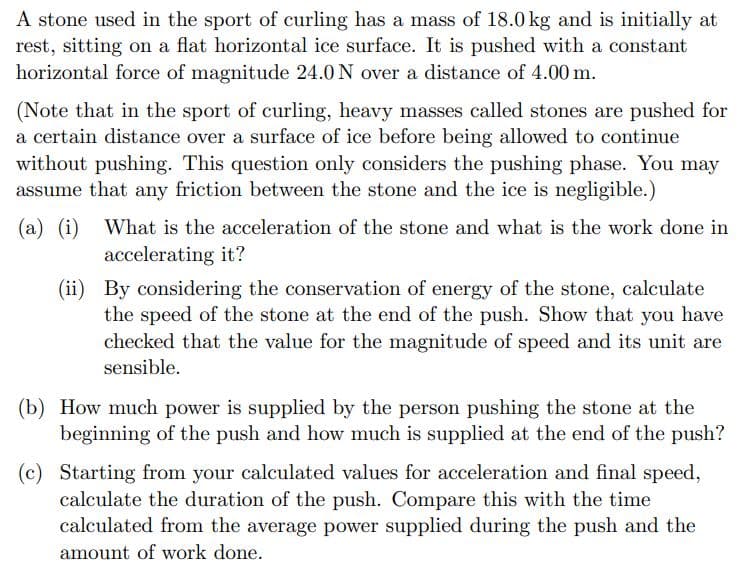A stone used in the sport of curling has a mass of 18.0 kg and is initially at rest, sitting on a flat horizontal ice surface. It is pushed with a constant horizontal force of magnitude 24.0 N over a distance of 4.00 m. (Note that in the sport of curling, heavy masses called stones are pushed for a certain distance over a surface of ice before being allowed to continue without pushing. This question only considers the pushing phase. You may assume that any friction between the stone and the ice is negligible.) (a) (i) What is the acceleration of the stone and what is the work done in accelerating it? (ii) By considering the conservation of energy of the stone, calculate the speed of the stone at the end of the push. Show that you have checked that the value for the magnitude of speed and its unit are sensible. (b) How much power is supplied by the person pushing the stone at the beginning of the push and how much is supplied at the end of the push? (c) Starting from your calculated values for acceleration and final speed, calculate the duration of the push. Compare this with the time calculated from the average power supplied during the push and the amount of work done.
A stone used in the sport of curling has a mass of 18.0 kg and is initially at rest, sitting on a flat horizontal ice surface. It is pushed with a constant horizontal force of magnitude 24.0 N over a distance of 4.00 m. (Note that in the sport of curling, heavy masses called stones are pushed for a certain distance over a surface of ice before being allowed to continue without pushing. This question only considers the pushing phase. You may assume that any friction between the stone and the ice is negligible.) (a) (i) What is the acceleration of the stone and what is the work done in accelerating it? (ii) By considering the conservation of energy of the stone, calculate the speed of the stone at the end of the push. Show that you have checked that the value for the magnitude of speed and its unit are sensible. (b) How much power is supplied by the person pushing the stone at the beginning of the push and how much is supplied at the end of the push? (c) Starting from your calculated values for acceleration and final speed, calculate the duration of the push. Compare this with the time calculated from the average power supplied during the push and the amount of work done.
College Physics
11th Edition
ISBN:9781305952300
Author:Raymond A. Serway, Chris Vuille
Publisher:Raymond A. Serway, Chris Vuille
Chapter1: Units, Trigonometry. And Vectors
Section: Chapter Questions
Problem 1CQ: Estimate the order of magnitude of the length, in meters, of each of the following; (a) a mouse, (b)...
Related questions
Question
100%

Transcribed Image Text:A stone used in the sport of curling has a mass of 18.0 kg and is initially at
rest, sitting on a flat horizontal ice surface. It is pushed with a constant
horizontal force of magnitude 24.0 N over a distance of 4.00 m.
(Note that in the sport of curling, heavy masses called stones are pushed for
a certain distance over a surface of ice before being allowed to continue
without pushing. This question only considers the pushing phase. You may
assume that any friction between the stone and the ice is negligible.)
(a) (i) What is the acceleration of the stone and what is the work done in
accelerating it?
(ii)
By considering the conservation of energy of the stone, calculate
the speed of the stone at the end of the push. Show that you have
checked that the value for the magnitude of speed and its unit are
sensible.
(b) How much power is supplied by the person pushing the stone at the
beginning of the push and how much is supplied at the end of the push?
(c) Starting from your calculated values for acceleration and final speed,
calculate the duration of the push. Compare this with the time
calculated from the average power supplied during the push and the
amount of work done.
Expert Solution
This question has been solved!
Explore an expertly crafted, step-by-step solution for a thorough understanding of key concepts.
Step by step
Solved in 3 steps with 3 images

Knowledge Booster
Learn more about
Need a deep-dive on the concept behind this application? Look no further. Learn more about this topic, physics and related others by exploring similar questions and additional content below.Recommended textbooks for you

College Physics
Physics
ISBN:
9781305952300
Author:
Raymond A. Serway, Chris Vuille
Publisher:
Cengage Learning

University Physics (14th Edition)
Physics
ISBN:
9780133969290
Author:
Hugh D. Young, Roger A. Freedman
Publisher:
PEARSON

Introduction To Quantum Mechanics
Physics
ISBN:
9781107189638
Author:
Griffiths, David J., Schroeter, Darrell F.
Publisher:
Cambridge University Press

College Physics
Physics
ISBN:
9781305952300
Author:
Raymond A. Serway, Chris Vuille
Publisher:
Cengage Learning

University Physics (14th Edition)
Physics
ISBN:
9780133969290
Author:
Hugh D. Young, Roger A. Freedman
Publisher:
PEARSON

Introduction To Quantum Mechanics
Physics
ISBN:
9781107189638
Author:
Griffiths, David J., Schroeter, Darrell F.
Publisher:
Cambridge University Press

Physics for Scientists and Engineers
Physics
ISBN:
9781337553278
Author:
Raymond A. Serway, John W. Jewett
Publisher:
Cengage Learning

Lecture- Tutorials for Introductory Astronomy
Physics
ISBN:
9780321820464
Author:
Edward E. Prather, Tim P. Slater, Jeff P. Adams, Gina Brissenden
Publisher:
Addison-Wesley

College Physics: A Strategic Approach (4th Editio…
Physics
ISBN:
9780134609034
Author:
Randall D. Knight (Professor Emeritus), Brian Jones, Stuart Field
Publisher:
PEARSON